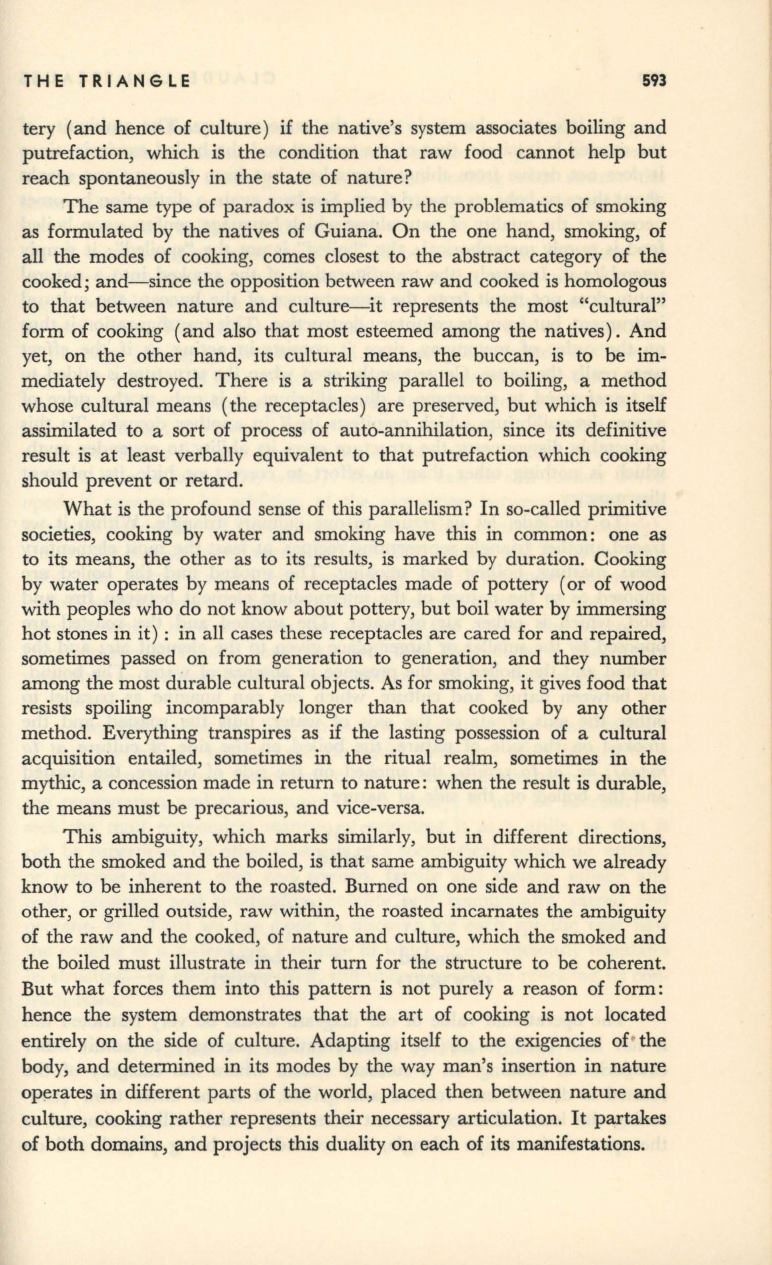
THE TRIANGLE
593
tery (and hence of culture) if the native's system associates boiling and
putrefaction, which is the condition that raw food cannot help but
reach spontaneously in the state of nature?
The same type of paradox is implied by the problematics of smoking
as formulated by the natives of Guiana. On the one hand, smoking, of
all the modes of cooking, comes closest to the abstract category of the
cooked; and-since the opposition between raw and cooked is homologous
to that between nature and culture-it represents the most "cultural"
form of cooking (and also that most esteemed among the natives). And
yet, on the other hand, its cultural means, the buccan, is to be im–
mediately destroyed. There is a striking parallel to boiling, a method
whose cultural means (the receptacles) are preserved, but which is itself
assimilated to a sort of process of auto-annihilation, since its definitive
result is at least verbally equivalent to that putrefaction which cooking
should prevent or retard.
What is the profound sense of this parallelism? In so-called primitive
societies, cooking by water and smoking have this in common: one as
to its means, the other as to its results, is marked by duration. Cooking
by water operates by means of receptacles made of pottery (or of wood
with peoples who do not know about pottery, but boil water by immersing
hot stones in it) : in all cases these receptacles are cared for and repaired,
sometimes passed on from generation to generation, and they number
among the most durable cultural objects. As for smoking, it gives food that
resists spoiling incomparably longer than that cooked by any other
method. Everything transpires as if the lasting possession of a cultural
acquisition entailed, sometimes in the ritual realm, sometimes in the
mythic, a concession made in return to nature: when the result is durable,
the means must be precarious, and vice-versa.
This ambiguity, which marks similarly, but in different directions,
both the smoked and the boiled, is that same ambiguity which we already
know to be inherent to the roasted. Burned on one side and raw on the
other, or grilled outside, raw within, the roasted incarnates the ambiguity
of the raw and the cooked, of nature and culture, which the smoked and
the boiled must illustrate in their turn for the structure to be coherent.
But what forces them into this pattern is not purely a reason of form:
hence the system demonstrates that the art of cooking is not located
entirely on the side of culture. Adapting itself to the exigencies of the
body, and determined in its modes by the way man's insertion in nature
operates in different parts of the world, placed then between nature and
culture, cooking rather represents their necessary articulation.
It
partakes
of both domains, and projects this duality on each of its manifestations.


